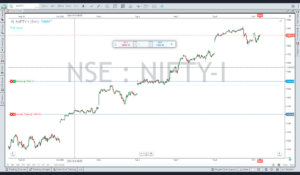
Understanding Nifty Open Interest (OI) is of the utmost importance in the complicated options trading world. The Nifty, which represents India’s top 50 corporations, serves as a gauge for the stock market. Open Interest, an essential indicator, measures the total number of outstanding contracts.
The article digs into the subtle interplay between Nifty and Open Interest, unraveling their mechanisms as well as investigating their significance in the options market. Understanding Nifty Open Interest serves as essential for recognizing trends in order to make informed trading decisions. Let’s traverse this critical part of options trading and grasp its significance for investors.
Nifty Open Interest- An Overview
What Is Nifty?
Nifty, short for National Stock Exchange Fifty, is India’s flagship stock market index, encompassed by the country’s top 50 actively listed companies. It acts as a benchmark for Indian equities markets, demonstrating their overall performance.
Traders and investors alike actively track Nifty fluctuations in order to assess market trends as well as make educated decisions, making it a critical indicator in India’s financial environment.
What is Open Interest in Trading?
In trading, open interest (OI) refers to the total number of outstanding contracts (such as options or futures) held by market players at any particular time. It demonstrates the complete commitment of traders to a certain financial product.
Unlike trading volume, which measures transactions over a set time period, OI accounts for all current contracts, signaling market liquidity as well as prospective fluctuations in prices. High OI signifies considerable investor interest and has the potential to influence market mood as well as trading techniques.
How Does It Apply to Nifty Options?
Open Interest (OI) is an important indicator in the world of Nifty options. It represents the total amount of Nifty option contracts in the market. Rising OI frequently indicates possible price fluctuations, indicating higher investor interest.
High levels of open interest at specific strike prices may function as support or resistance, influencing trading techniques.
Traders utilize changes in Nifty Open Interest to predict market movements, allowing them to make well-informed decisions about buying or selling options along with improving their ability to deal with the complexity of the Nifty options market.

The Mechanics of Open Interest
The total number of outstanding option contracts in the market is represented by open interest (OI). Understanding how it works is critical for traders:
1. Constantly Changing: OI fluctuates as new contracts are created or existing contracts are closed.
2. Longs and Shorts: In the options market, for every buyer (long), there is a seller (short), resulting in equal OI.
3. There will be no zero-sum games: Options contracts, unlike stocks, do not vanish when traded; rather, they are transferred from one party to another.
4. OI Trends: Rising OI indicates new money entering the market, implying future price moves. A decrease in OI may indicate market consensus or a trend reversal.
5. Contract Expiry: As options approach their expiry date, OI normally drops, suggesting less market interest.
Interpreting Nifty Open Interest
For traders, interpreting Nifty Open Interest (OI) is critical. High open interest at specific strike prices frequently signals considerable market interest, indicating potential support or resistance levels. Rising OI with rising market price indicates a bullish trend, showing investor confidence when combined with price changes.
In contrast, dropping OI with falling prices shows a gloomy sentiment, implying a possible decline. However, traders should exercise caution; unusually high OI may suggest overbought or oversold situations, prompting them to examine other indicators for a more complete market picture.
A careful assessment of Nifty Open Interest assists traders in anticipating market movements and making informed trading decisions.

Using Nifty Open Interest in Options Trading
The utilization of Nifty Open Interest (OI) in strategic options trading is of the utmost importance for traders to make informed decisions:
1. Trend Confirmation: High OI validates current market trends, giving traders confidence in their trading strategies.
2. Identifying Support and Resistance: Different OI levels are used to indicate support or resistance, directing entry and exit places.
3. Contrarian Signals: When OI as well as price movements diverge, it is possible to predict future reversals, making it possible to timely trades.
4. Volume Confirmation: Increased volume of trade and high OI boost trend dependability.
5. Rolling Strategies: Monitoring OI changes helps in rolling options positions as well as optimizing profitability.
6. Event Anticipation: Prior to events, OI analysis provides insights into market mood, assisting risk management techniques.
Traders can use Nifty Open Interest for more effective as well as accurate options methods of trading through the integration of the data above.
Nifty Open Interest – Final Verdict
Nifty Open Interest (OI) emerges as a powerful ally in the volatile world of options trading, guaranteeing traders distinctive perspectives. The conclusion is unequivocal, understanding and employing Nifty Open Interest is critical for making informed judgments. It serves as an indicator for traders, directing them through market mood, probable price fluctuations, as well as smart entry or exit locations.
Traders get a competitive advantage by precisely assessing OI data, allowing them to prepare for fluctuations in the market, identify levels of support or resistance, and manage tumultuous situations.
Finally, embracing Nifty Open Interest offers traders an advanced perspective, changing market complexities into strategic possibilities as well as increasing their overall effectiveness in the world of options trading.